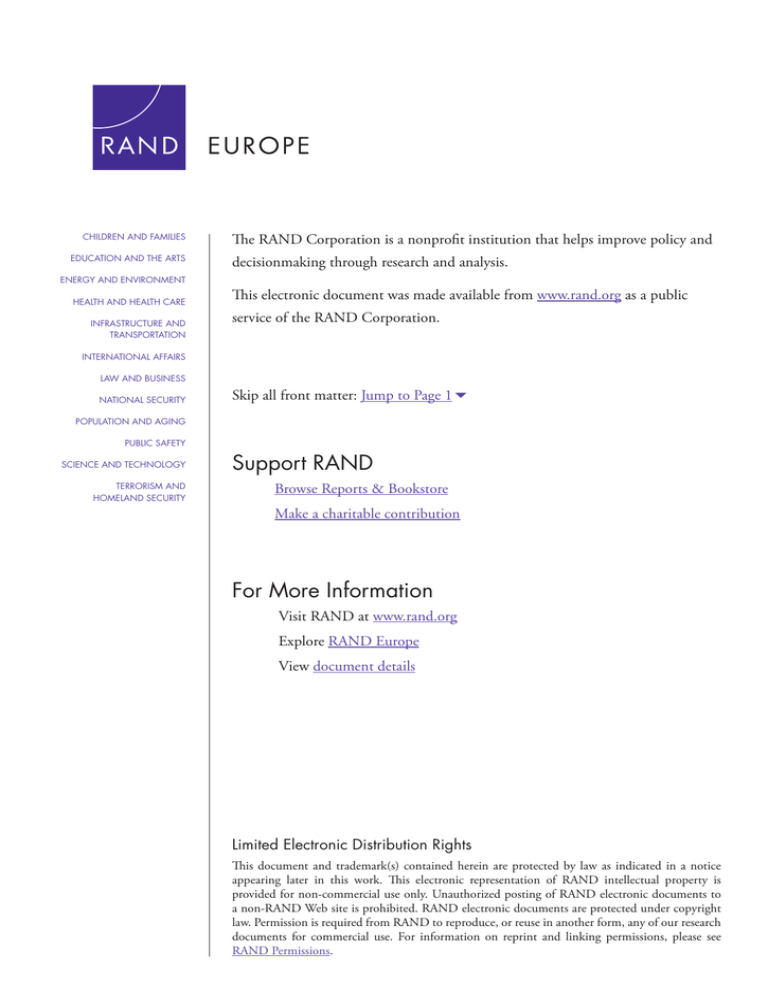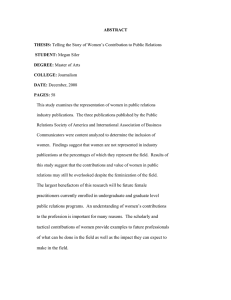The RAND Corporation is a nonprofit institution that helps improve... decisionmaking through research and analysis.
advertisement

CHILDREN AND FAMILIES EDUCATION AND THE ARTS The RAND Corporation is a nonprofit institution that helps improve policy and decisionmaking through research and analysis. ENERGY AND ENVIRONMENT HEALTH AND HEALTH CARE INFRASTRUCTURE AND TRANSPORTATION This electronic document was made available from www.rand.org as a public service of the RAND Corporation. INTERNATIONAL AFFAIRS LAW AND BUSINESS NATIONAL SECURITY Skip all front matter: Jump to Page 16 POPULATION AND AGING PUBLIC SAFETY SCIENCE AND TECHNOLOGY TERRORISM AND HOMELAND SECURITY Support RAND Browse Reports & Bookstore Make a charitable contribution For More Information Visit RAND at www.rand.org Explore RAND Europe View document details Limited Electronic Distribution Rights This document and trademark(s) contained herein are protected by law as indicated in a notice appearing later in this work. This electronic representation of RAND intellectual property is provided for non-commercial use only. Unauthorized posting of RAND electronic documents to a non-RAND Web site is prohibited. RAND electronic documents are protected under copyright law. Permission is required from RAND to reproduce, or reuse in another form, any of our research documents for commercial use. For information on reprint and linking permissions, please see RAND Permissions. This product is part of the RAND Corporation documented briefing series. RAND documented briefings are based on research briefed to a client, sponsor, or targeted audience and provide additional information on a specific topic. Although documented briefings have been peer reviewed, they are not expected to be comprehensive and may present preliminary findings. Funding and performance on clinical guidelines The cases of dementia and chronic obstructive pulmonary disease Emmanuel Hassan, Helen Ridsdale, Jonathan Grant, Susan Guthrie Prepared for the UK Medical Research Council, the Wellcome Trust and the Department of Health (England) EUROPE The research described in this report was prepared for the UK Medical Research Council, the Wellcome Trust and the Department of Health (England). RAND Europe is an independent, not-for-profit research organisation whose mission is to improve policy and decision making for the public good. RAND’s publications do not necessarily reflect the opinions of its research clients and sponsors. R® is a registered trademark. © Copyright 2012 RAND Corporation Permission is given to duplicate this document for personal use only, as long as it is unaltered and complete. Copies may not be duplicated for commercial purposes. Unauthorized posting of RAND documents to a non-RAND website is prohibited. RAND documents are protected under copyright law. For information on reprint and linking permissions, please visit the RAND permissions page (http://www.rand.org/publications/ permissions.html). Published 2012 by the RAND Corporation 1776 Main Street, P.O. Box 2138, Santa Monica, CA 90407-2138 1200 South Hayes Street, Arlington, VA 22202-5050 4570 Fifth Avenue, Suite 600, Pittsburgh, PA 15213-2665 Westbrook Centre, Milton Road, Cambridge CB4 1YG, United Kingdom RAND URL: http://www.rand.org RAND Europe URL: http://www.rand.org/randeurope To order RAND documents or to obtain additional information, contact Distribution Services: Telephone: (310) 451-7002; Fax: (310) 451-6915; Email: order@rand.org Executive summary Objectives This document details an exploratory investigation into the characteristics of research cited in two clinical guidelines produced by the National Institute of Health and Clinical Excellence (NICE) in the United Kingdom (UK): that on Dementia, published in 2006, and on Chronic Obstructive Pulmonary Disorder (COPD), published in 2004. More precisely, this document addresses the following questions. What are the characteristics of publications cited in these clinical guidelines? On those papers with a UK affiliation, who funded the research cited in these clinical guidelines? The work is part of an overall drive among funders to understand better how research reaches policy and practice. Method In order to address these questions, we conducted bibliometric analysis on all the publications cited in the two guidelines and indexed in the bibliometric database, the Web of Science. Different bibliometric indicators were selected to assess the various actors’ contribution in the research cited in the two guidelines, the collaboration between them in this research and the wider impact of their scientific contribution in the research community. We subsequently examined the funding acknowledgments in all publications with at least one UK-based author cited in the guidelines under investigation. This was done using information extracted from various bibliographic databases such as the Research Output Databases (ROD) (Dawson et al., 1998; Webster et al., 2003), as well as the full text of these publications. In addition, this analysis was intended to offer insight into the issue of the time lag between research, its publication in the peer-reviewed literature and its appearance in a clinical guideline – and hence the potential impact of research on policy. Data preparation We began with 491 references for COPD and 775 for Dementia. Extracting and cleaning the references included in each guideline gave us a total of 412 and 616 publications cited in the COPD and the Dementia guidelines respectively. v Funding and performance on clinical guidelines RAND Europe These publications were cross-referenced against the Web of Science to conduct the bibliometric analysis. Of 412 publications extracted from the COPD guideline, 335 (81.3%) were indexed in the Web of Science. For the publications cited in the Dementia guideline, 494 (80.1%) of the 616 extracted were indexed in the same database. Of the publications extracted from these two guidelines, we identified those with at least one UK author in order to carry out the funding analysis. Using information from various databases, we found that 148 (35.9%) publications extracted from the COPD had at least one UK author. Of the 616 publications extracted from the Dementia guideline, 228 (37.2%) had at least one UK author. Main findings and future research directions The main findings of our exploratory study are as follows. Research funding About half of the publications cited in the two guidelines with at least one UK author (40.5% for COPD, 45.6% for Dementia) do not include any funding acknowledgement. The dearth in funding acknowledgement information seems to be related to the age of the publication: more recent publications have more complete funding acknowledgements than older ones. Of those publications that did acknowledge funding, the sources included industry, not-for-profit, hospital trusts, government agencies, local or regional authorities, foundations and government departments. Industry was the dominant funder acknowledged by COPD publications, but there was no dominant funder among the Dementia publications. Several key UK funders (Medical Research Council (MRC), Department of Health (England), the National Health Service (NHS) and the Wellcome Trust) were acknowledged only to a limited extent, and more frequently in publications cited in the Dementia guideline than in those cited in the COPD guideline. Characteristics of publications cited in clinical guidelines More than half of the publications cited in both guidelines were published within five years of the guidelines’ release, which corroborates the findings from earlier studies on UK clinical guidelines. In their study on UK clinical guidelines related to cancer published up to 2006, Lewison and Sullivan (2008) found a peak of cited publications after 2000. Other works on UK clinical guidelines discovered that a significant share of the publications they cite are published within 10 years prior to the release of these guidelines (for example, Grant et al., 2000; Buxton et al., 2009). More than 35% of publications cited in these two UK clinical guidelines featured at least one author with a UK affiliation. This proportion is high, given that the UK share in all publications published in medical research at the global level was approximately 8.6% in 2006 (Hassan, 2009).1 This ‘overrepresentation’ of UK- 1 The UK share in biomedical sciences at the global level was calculated by the French Observatoire des Sciences et des Techniques using the Web of Science database (Esterle et al., 2008). This share was calculated based on the fractional counting of multi-authored publications, while in this document we use whole vi RAND Europe Funding and performance on clinical guidelines authored publications in UK clinical guidelines is in line with the results of previous studies, although earlier studies have found overall lower shares of UKauthored publications cited in UK clinical guidelines (Grant et al., 2000; Lewison and Sullivan, 2008; Buxton et al., 2009). The publications cited in the two guidelines have a high impact in the scientific community, as reflected in the field-normalised citation score. Publicly-funded research institutes produced the papers with the highest citation scores (more than 8 for COPD and around 24 for Dementia), with companies ranking second in terms of citation scores. Similarly, previous studies on UK clinical guidelines have underlined the high scientific impact of the publications they cite. Most of the publications (more than 80%) cited in both guidelines are copublications between authors from different institutions at the national or international level. The results of this exploratory work raise several questions for future research. Specific questions related to clinical guidelines Is there a systematic selection bias, such that the authors of the UK clinical guidelines are more likely to cite UK-authored and UK-focused research? Obviously, this would be expected if they concern local health issues, but could the bias extend beyond this? Is there a bias towards the inclusion of highly-cited publications in UK clinical guidelines? Does inclusion of a research paper in a clinical guideline lead to subsequent citations? What type of research (e.g. basic, clinical) is cited most often in UK clinical guidelines? Can the publications cited in clinical guidelines be used to help us estimate the time lags between research, publication and potential influence on policy and practice resulting from inclusion in a clinical guideline? Broader questions related to the relation between research funding and performance What is the relationship between the institutional origin of research funding and scientific performance? What is the relationship between the type of research funding and scientific performance? counting. Thus, our results might overestimate slightly the share of cited publications featuring at least one author with a UK affiliation. vii




